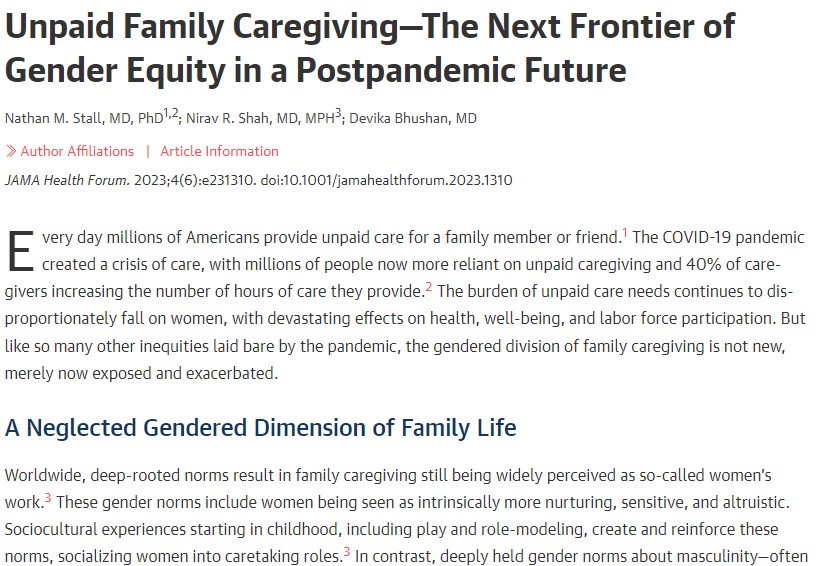Unpaid Family Caregiving – Neglected Gender Norms
https://jamanetwork.com/journals/jama-health-forum/fullarticle/2805890
Unpaid Family Caregiving – The Next Frontier of Gender Equity in a Post-Pandemic Future
Nathan M. Stall, MD, PhD1,2; Nirav R. Shah, MD, MPH3; Devika Bhushan, MD
Author Affiliations Article Information
JAMA Health Forum. 2023;4(6):e231310. doi:10.1001/jamahealthforum.2023.1310

June 9, 2023 – Every day millions of Americans provide unpaid care for a family member or friend.1 The COVID-19 pandemic created a crisis of care, with millions of people now more reliant on unpaid caregiving and 40% of caregivers increasing the number of hours of care they provide. The burden of unpaid care needs continues to disproportionately fall on women, with devastating effects on health, well-being, and labor force participation. But like so many other inequities laid bare by the pandemic, the gendered division of family caregiving is not new, merely now exposed and exacerbated.
A Neglected Gendered Dimension of Family Life
Worldwide, deep-rooted norms result in family caregiving still being widely perceived as so-called women’s work. These gender norms include women being seen as intrinsically more nurturing, sensitive, and altruistic. Sociocultural experiences starting in childhood, including play and role-modeling, create and reinforce these norms, socializing women into caretaking roles.3 In contrast, deeply held gender norms about masculinity—often defined in opposition to femininity—create barriers for men to act as caregivers.3 Accordingly, US women provide 2.2 times more unpaid family caregiving on a time-per-day basis relative to men.4 Over the last half century, society has made some—albeit inadequate—gains in tackling the gendered divisions of childcare and housework, but the gender imbalance in the third dimension of family life, unpaid caregiving, remains relatively uncontested.
Modern Family Caregiving: Complex Care Without Adequate Training or Support
While family caregivers traditionally provided emotional and basic support with household tasks and personal care, an increase in home-based health care needs now sees unpaid caregivers being expected to assume more complex roles with little to no training or support. More than half of all caregivers perform medical tasks typically done by health care workers like nurses, pharmacists, or respiratory therapists. Family caregivers are also expected to help navigate complicated health care and social service systems, understand and track complex health information, and serve as surrogate care coordinators, advocates, and decision-makers.1
Do Current Health Care Reforms Institutionalize the Marginalization of Women?
Current health care reforms, including value-based and accountable care, are increasingly decentralizing care away from inpatient settings toward the home and community. These shifts are based on the implicit assumption that family caregivers—the majority of whom are women—will provide this increasingly complex care at home without additional support.7 Family caregivers are estimated to provide approximately 80% of direct home-based and community-based care services, unpaid contributions valued at $600 billion US dollars annually. Yet family caregivers are largely socially and politically invisible, and their very real and necessary labor lies outside the market economy.
The Physical, Mental, and Economic Burdens of Caregiving Disproportionately Experienced by Women
While caregiving can be personally rewarding, for many it can create cumulative physical and psychological strain that is health damaging.1 Compared with non-caregivers, family caregivers, especially women, experience increased emotional distress, depression, anxiety, and social isolation; impaired physical health; decreased preventive and self-care behaviors; greater acute care use; and even increased mortality.
A total of 60% of caregivers are juggling unpaid caregiving with paid job responsibilities. Many are forced to cut back on their work hours, take leaves of absence, or exit the workforce altogether. These disruptions in employment, exacerbated by the COVID-19 pandemic, reduce family caregivers’ income, Social Security benefits, and other retirement benefits, resulting in caregiver financial insecurity and an estimated productivity loss of $30 billion to the US economy annually.1
Supporting Caregivers Requires Comprehensive Policy Interventions + Opposing Gendered Caregiving Norms
The 2016 Families Caring for an Aging America report and the 2022 National Strategy to Support Family Caregivers recognize that caregiving occurs within a multifaceted context, and recommend that interventions be directed at the caregiver, workplace and health care organization, and societal levels.1,8 Successful implementation of these policy interventions will require a gender-based lens, which challenges gendered norms that treat women as expected and primary caregivers and men as inauthentic and secondary caregivers.3
Caregiver-Level Interventions
Effective caregiver interventions are generally multidimensional and include problem-solving, skills training, support groups, counseling, family therapy, and respite.6 Since caregiving is often viewed as a natural part of women’s work, women caregivers are both less likely to receive assistance from family and friends, and to use external caregiving services and support.9 As such, female caregivers may need a higher intensity of caregiver support, and specific outreach efforts to ensure acceptability and accessibility.
In April 2023, the US Biden-Harris Administration announced a set of executive orders focused on caregiving, including increased respite care, more support during the discharge planning process, and expanded mental health supports.10
Workplace-Level and Health Systems-Level Interventions
Caregiver-friendly workplace policies can help men and women manage their caregiving responsibilities without compromising financial security or career advancement. These policies include flexible working hours and arrangements, topping up and extending publicly available family leave benefits and employee assistance programs that involve support groups, counseling, and skills workshops.8
There is also a pressing need for reforms to public and private health insurance plans that largely exclude family caregivers from receiving direct services or financial and other supports—which are limited to the person directly receiving care—despite the well-documented health effects of family caregiving.7 This is detrimental to both patient and caregiver health.
Societal-Level Interventions
While health care movements such as person-centered and family-centered care have raised the profile of family caregiving, there remains a need for much greater awareness about the intensity and complexity of roles that caregivers assume and the challenges that they face.1,6–8 The National Strategy to Support Family Caregivers calls for a national and culturally competent awareness campaign.8 This would be strengthened by including a focus on the gendered division of family caregiving, such that policy makers and the public could understand the inherent risks to women’s self-determination, health, and financial security posed by policies that promote and rely heavily on unpaid family caregivers, the majority of whom are women.7
The US is unique among its economic peers in lacking universal and robust provisions for paid family leave. The 1993 Family and Medical Leave Act guarantees just 12 weeks of unpaid job-protected leave to care for a parent, spouse, or child with a serious health condition, and this is only available to 60% of caregivers in the workforce. A national paid family leave program that uses the broadest possible definition of family for eligibility would help ensure that equity-deserving groups—including women—could best benefit from such a program.8 Family caregivers could be further financially protected by allowing them to accrue Social Security credits while on caregiving leave and by offering refundable tax credits for caregiving-related expenses.
Finally, the COVID-19 pandemic has accelerated the need for long-term care financing reform. Currently, more than half of all long-term care costs in the US are paid out-of-pocket. When this cannot be afforded, family caregivers often assume financial and direct care responsibilities. The National Strategy to Support Family Caregivers advocates for a national public long-term care social insurance program, that includes benefits for caregivers. This would guarantee coverage of a flexible set of goods and services—including home care, meals, and equipment—necessary for maintaining community status.
Conclusions
The COVID-19 pandemic has spotlighted the critical role of unpaid family caregiving, how women disproportionately assume these responsibilities, and how they bear the physical, mental, and financial consequences of doing so. Challenging this gendered dimension of family life is essential to better supporting caregivers (including men who are caregivers and nonbinary caregivers), ensuring that caregiver interventions are equitably implemented, and creating a more equitable and resilient society in a post-pandemic future.
Извор: WUNRN – 18.01.2024



